I hear you’re a set piece team now father – Analysis Thursday, 2nd May 2024 17:51 by Dan Lambert In his final analysis piece for LFW this season, Dan Lambert looks at how QPR went from being the worst team in the league for offensive set pieces to, eventually, kind of good. Our set pieces have been good of late, and that isn’t some kind of sick joke. It’s taken a hell of a while for them to be successful but, having scored 7 in our last 11 games, it’s been a significant correlation to our good run of form that has meant we have secured safety in the Championship for yet another season. It was presumed under Gareth Ainsworth’s stewardship that QPR were going to finally threaten regularly from dead ball situations, but amongst our technical squad we possess a lack of height bar the CBs, Field and Dykes. That proved unsuccessful and little changed in that department under Cifuentes with the help of a January transfer window, maybe with the exception of Isaac Hayden who is a rather long-legged midfielder. What he did bring in was a set piece taker in Andersen, who has improved the delivery, alongside utilising the height we do have to better effect and coming up with different routines that either exploit opposition structures or create ideas to suit the XI we have out on the pitch. We’ve still been poor in attacking set pieces across the year - joint third worst record in the league. However, the block of 11 games I’ll look at show a rough indicator of the vast improvement over the final quarter of the campaign as to how they can remain successful taking it into next season. I’ll explore the themes of them in further detail in this piece, but it’s worth noting at the top we have had success utilising height and targeting zones, second phases, maintaining structure and exploiting spaces. Principles just the same as breaking down an opposition team in open play. Leicester A, March 2, 2024 Deep free-kick situation. Initial target is the back post (Dunne). Have a 2v1 numerical advantage.  Aim is for Dunne to head it back across the box as he’s too deep to score himself. Lack of bodies in the box, four bodies edge of box are to maintain the second phase – Armstrong the highest of them with a deep late run.  Field (one of the few height players in the box) pins the defender and sets the ball for the run of Armstrong in a better scoring position.  Armstrong fires it home to double QPR’s lead, capitalising from a dead ball situation. This example was more of a second phase situation, not because the ball had been cleared but Armstrong’s late run and the different areas hit. Also utilised the height to attack the ball and pin players but using Dunne as the first contact target, and the likes of Field and Clarke Salter attacking the box as initial runners highlights how, in this scenario, the profiles were used correctly for how to attack the set piece. West Brom H, March 6, 2024This goal is very similar to the Leicester one, except it’s definitely a second phase goal as the corner gets missed and it comes out to Chair out wide to keep the set piece alive. 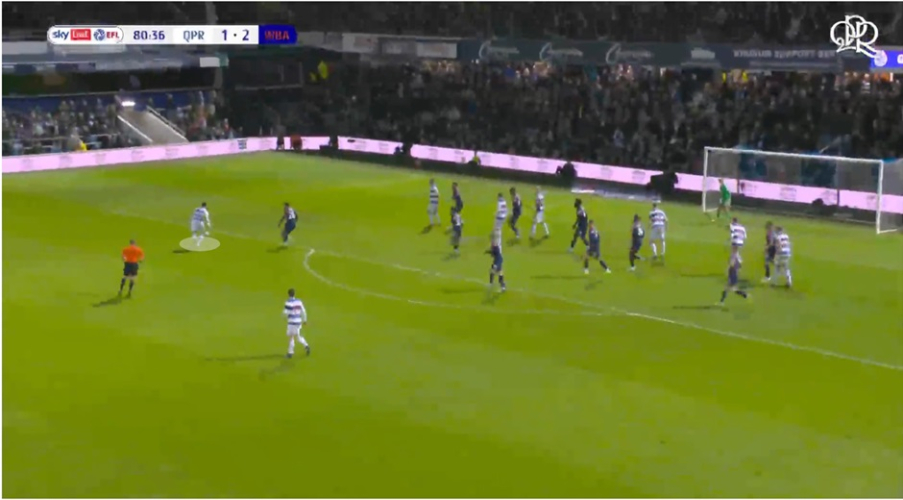 Chair with the ball from the corner drifting wide to look to find a cross. 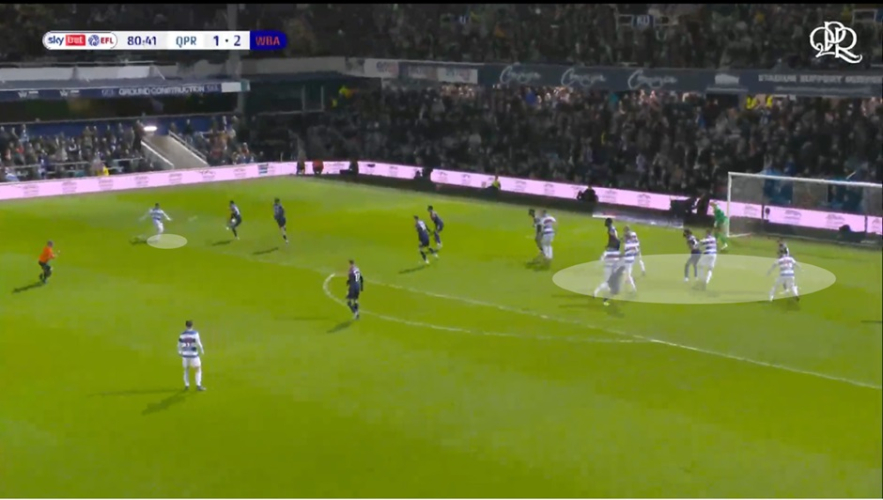 Chair delivers to the back post, with a 5v4 at the back post giving us a numerical advantage.  Dunne the ‘target’ for first contact wins the header and heads it across goal for numbers to attack. Behind that we have 2/3 players to attack the ball if it comes out and keep the set piece alive.  Field follows in the rebound to equalise. Some effective themes have been used thus far: Dunne as the aerial target for initial first phase contacts; Field’s role as a box attacker both in the sense of second phases or first phase layoffs; and the structure to keep the set pieces alive. Birmingham H, March 29, 2024A rather pivotal Bank Holiday Easter weekend for our survival hopes, games against two relegation threatened teams at the time, started in style beating Birmingham City, where collectively across the two games two of the three goals Rangers scored were from set pieces. 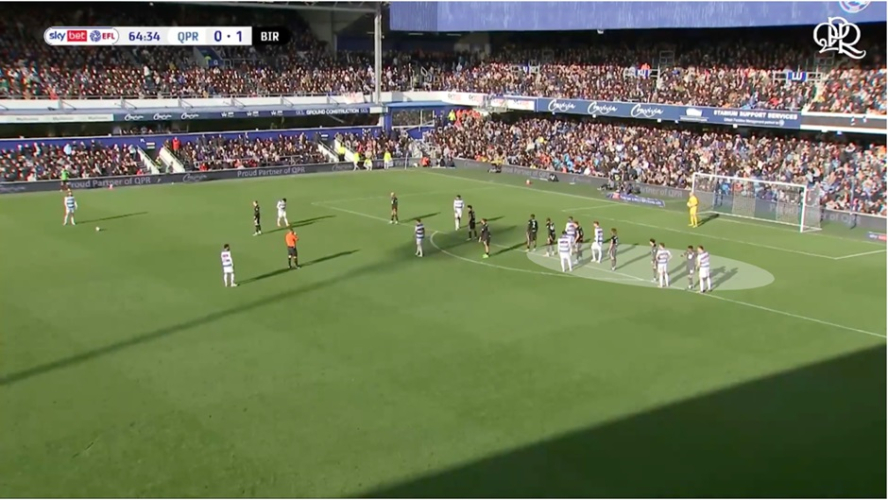 Deep free-kick – back post the ‘target zone’ for this set piece. 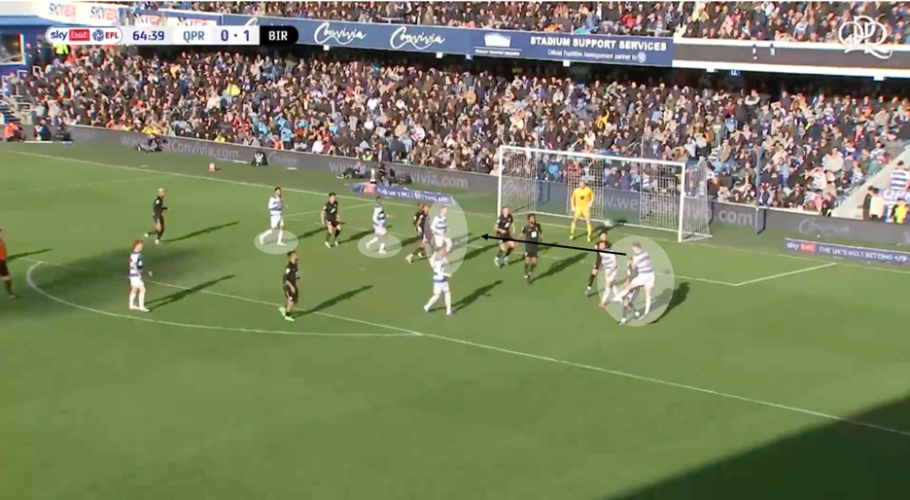 The delivery finds Dunne to win the first contact. Structure remains similar – three box attackers where the ball should be aimed for or there’s two players edge of box to initiate the second phase.  Field receives the header from Dunne, pins the defender similar to Leicester to layoff.  Cook volleys the layoff past Ruddy to equalise in the game. This was the first set piece Andersen took thus far, with Chair delivering in the first one and the second phase for West Brom so the consistency of delivery despite the taker has remained, strongly aiding the outcome of these routines. Swansea A, April 1, 2024This is the first of a few set pieces where themes still remain, however they’re routines that exploit the opposition space/weaknesses a lot more than gambling with aerial height in 1v1 contacts to keep the routines alive.  Outswinging corner. Front and back post spaces highlighted – looking to exploit that part of their set up through first contacts and runs. 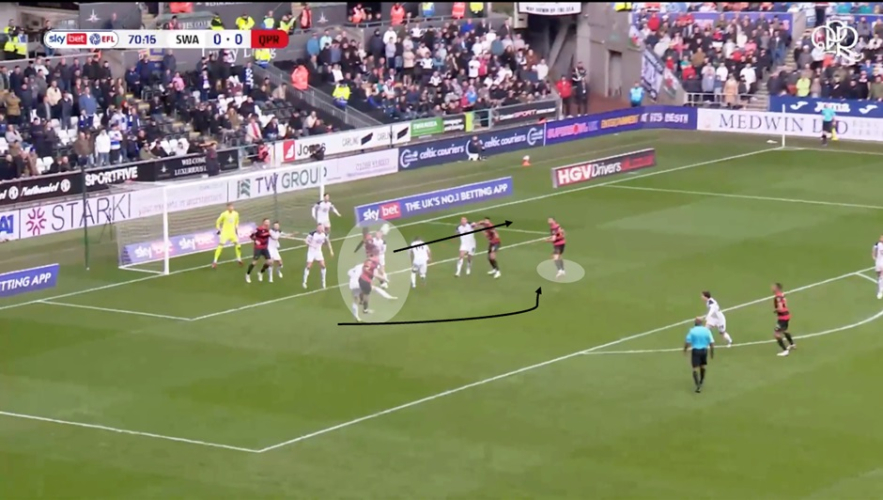 Dunne wins the first contact from the back post zone, aimed towards the front post zone. Cook’s curved run to attack the space allows Dunne to cushion a header his way. 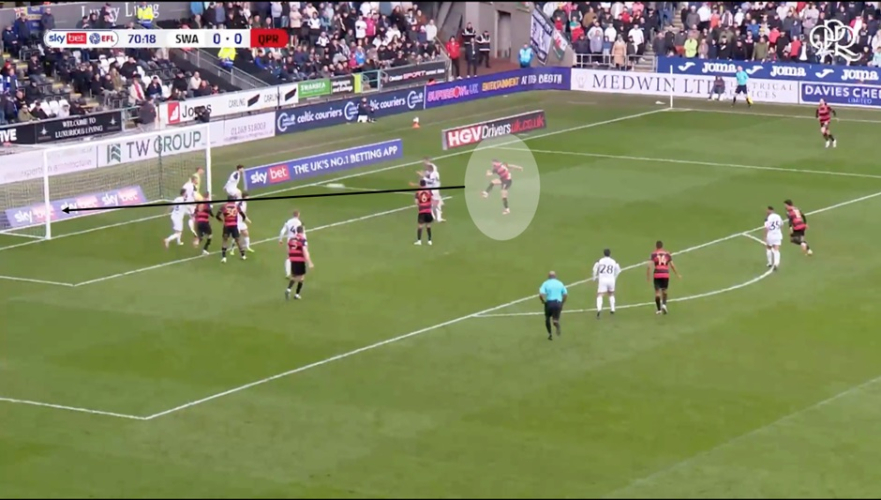 Cook fires a volley into the far corner to give Rangers the win on the day. Not only was that effective in highlighting spaces we exploited amongst the opposition but the Cook and Dunne partnership has formed utilising the strengths of their aerial ability well in set piece scenarios. Add in the fact that Dunne has been playing RB, him Cook and Clarke Salter provide aerial advantages in the box from dead ball situations. Plymouth A, April 9, 2024 Inswinging corner again, similar to Swansea. Back post space to be exploited through first contact. 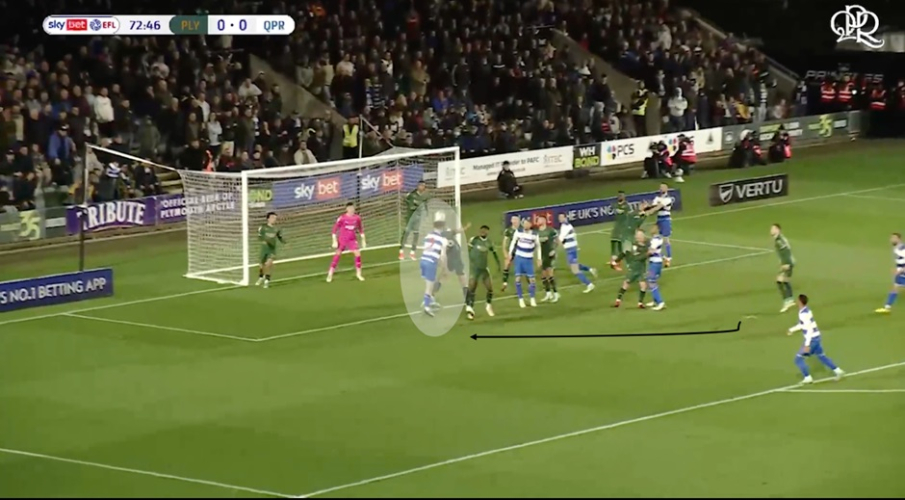 Dunne wins first contact and attacks the goal with his initial header.  The ball is attacked from the back post from Dunne’s initial header but is cleared off the line.  Sam Field is there again as a box attacker to head home and score another vital goal for the club. Field’s presence in these set pieces cannot be understated, especially as a late box crasher for the second phases or even utilising his height as a serious advantage. Field, Cook and Dunne have been key fundamentals in these set piece successes. Leeds H, April 26, 2024Not one but two goals were scored in this game, one from a corner and one from a free kick close to the corner flag. The same patterns emerge, attacking spaces in opposition set ups and utilising height to win first contacts.  As highlighted the front post zone was free in this set-up, with an inswinging delivery to get the ball closer to the front post/goal. 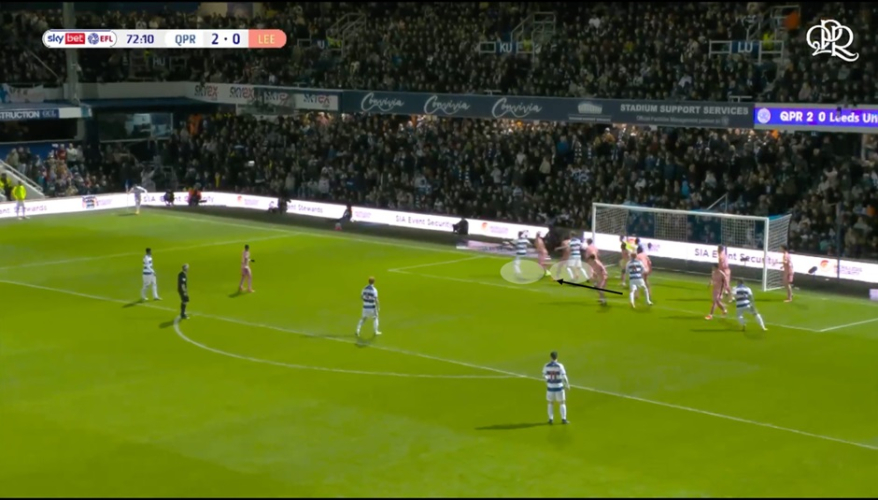 Dykes nudges his marker in advance of peeling off the six yard box to make a front post run to get infront of the defender. 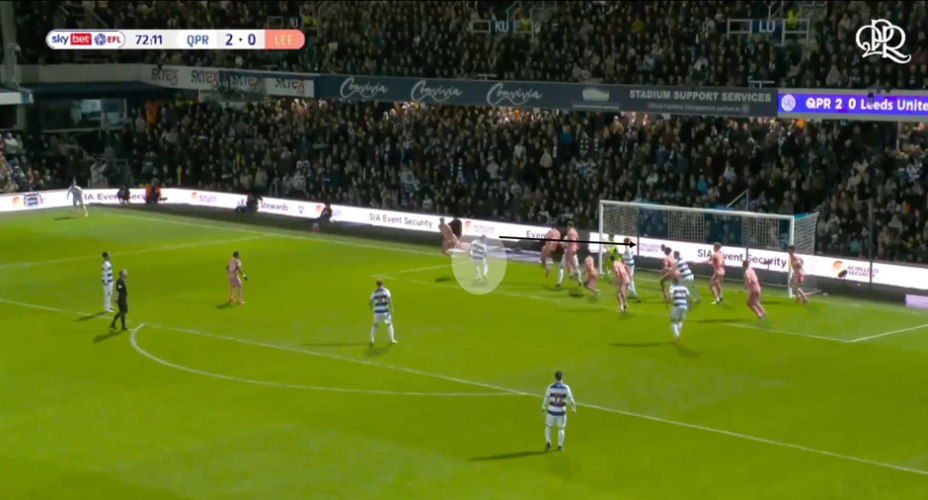 Dykes wins the flick on and scores past Meslier to put QPR 3-0 up. A simple, yet effective example of how to attack the space of an opposition’s set up, particularly their extreme zonal set-up across the six yard box. The same themes occur attacking their zonal set up across the six yard box with the second set piece goal. 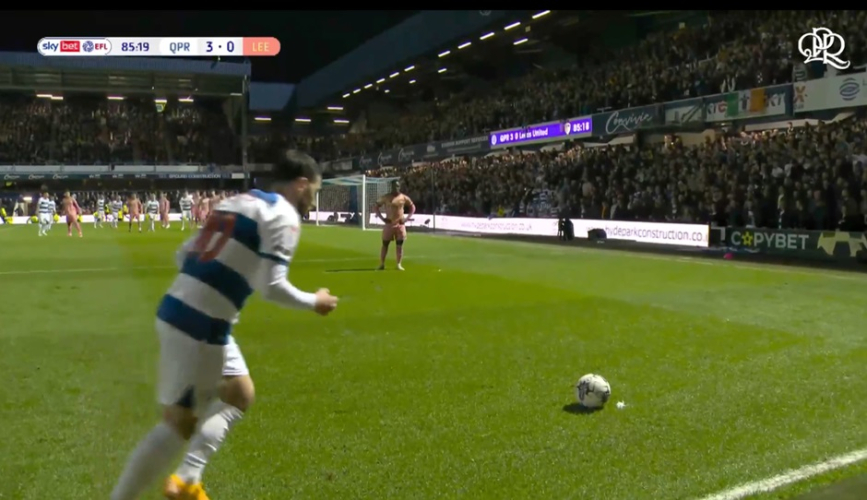 A Chair outswinging delivery. Four attackers across their zonal structure and two behind for the second phase.  Field (there he is again) rises above the two zonal markers to win the first contact and score past Meslier. Again, a simple yet effective routine at exploiting their zonal system rather than pure spaces like the previous example and many previous from other games. Repetitive principles and themes have helped Rangers to be successful when it comes to attacking set pieces in recent months which saw them score seven goals from their last 11 games. From winning first contacts to consistently good set piece delivery to attacking spaces well in opposition set-ups, if the principles can be carried across to next season we won’t be a side whose joint third worst at attacking set pieces in the league, we’ll be far higher and that will help us to gain additional points at climbing the table because as we well know set pieces are fine margins in football and fine margins in the Championship can climb you multiple places. A small run can put you at the other end of the table. Let it sink in – QPR, for the past three months, have been a very, very good set piece side Just hope it doesn’t end here. More from this author >>> More like this at Dan’s SubStack >>> What have we learned so far? >>> QPR’s attacking set pieces >>> Struggling to break down defences >>> Positive changes v Sheff Utd >>> Ainsworth’s structural headache >>> Suceeding without possession >>> Consistent, persistent failures without the ball >>> If you enjoy LoftforWords, please consider supporting the site through a subscription to our Patreon or tip us via our PayPal account loftforwords@yahoo.co.uk. Pictures — QPRPlusPass The Twitter @DanLambert__ Pictures - Ian Randall Photography Please report offensive, libellous or inappropriate posts by using the links provided.
You need to login in order to post your comments |
Blogs 31 bloggersManchester City Polls[ Vote here ] |
